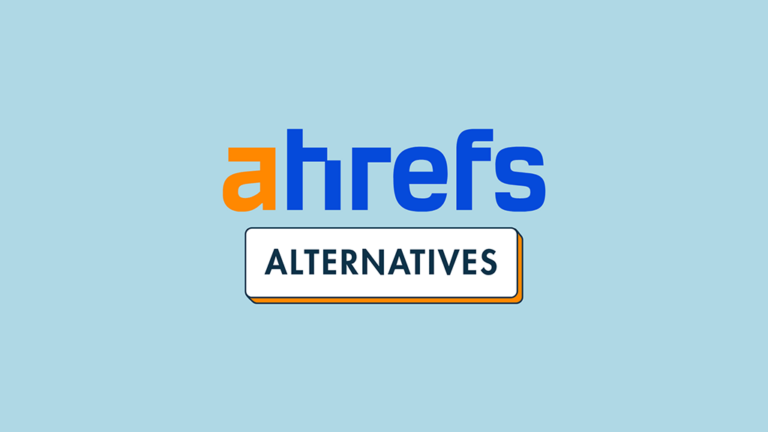
Ahrefs is one of the most powerful SEO platforms available, with excellent tools for backlink analysis, keyword research and site audits among many others. However, it’s also one of the more expensive options on the market — so in this guide to Ahrefs alternatives, I highlight some competing SEO tools that you might also want to consider.
ℹ️ Please note: This isn’t a ‘ranked’ list. I have simply highlighted the SEO platforms that based on my hands-on testing I believe are genuinely worth considering as alternatives to Ahrefs in 2025. The goal here is to help you find the right fit for your specific needs and budget.
Ahrefs alternatives — quick links
SE Ranking
If you’re looking for a more affordable SEO platform than Ahrefs — but one that offers a similar feature set — SE Ranking is one of the most compelling alternatives available. It starts at just $65 per month, which is roughly half the price of Ahrefs’ equivalent entry-level plan, but it still offers a full suite of tools for keyword tracking, backlink monitoring, site auditing and competitor analysis.
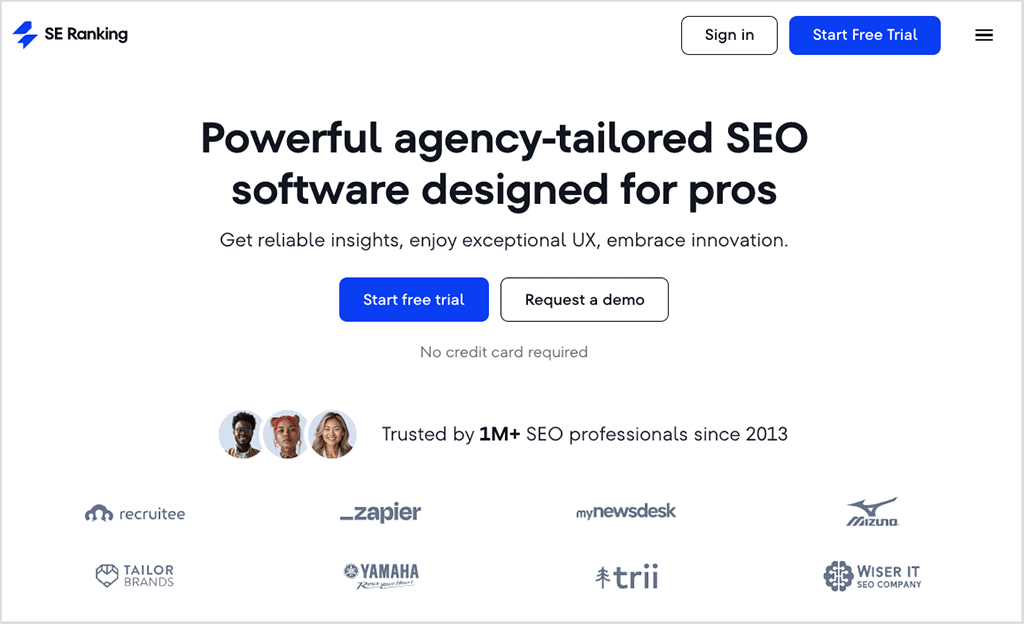
And despite its affordable price tag, SE Ranking is more generous than Ahrefs in some ways.
For example, its mid-tier $119-per-month ‘Pro’ plan lets you track the SEO performance of up to 30 websites, while Ahrefs’ $249-per-month ‘Standard’ plan limits you to tracking 20. And on SE Ranking’s $259-per-month ‘Business’ plan ($259 per month), you can track an unlimited number of sites — something Ahrefs only facilitates if you verify ownership of each and every site.
(In fact, even on Ahrefs’ most expensive plan — which costs $449 per month — you’re still capped at tracking 50 websites unless you can verify ownership of them.)
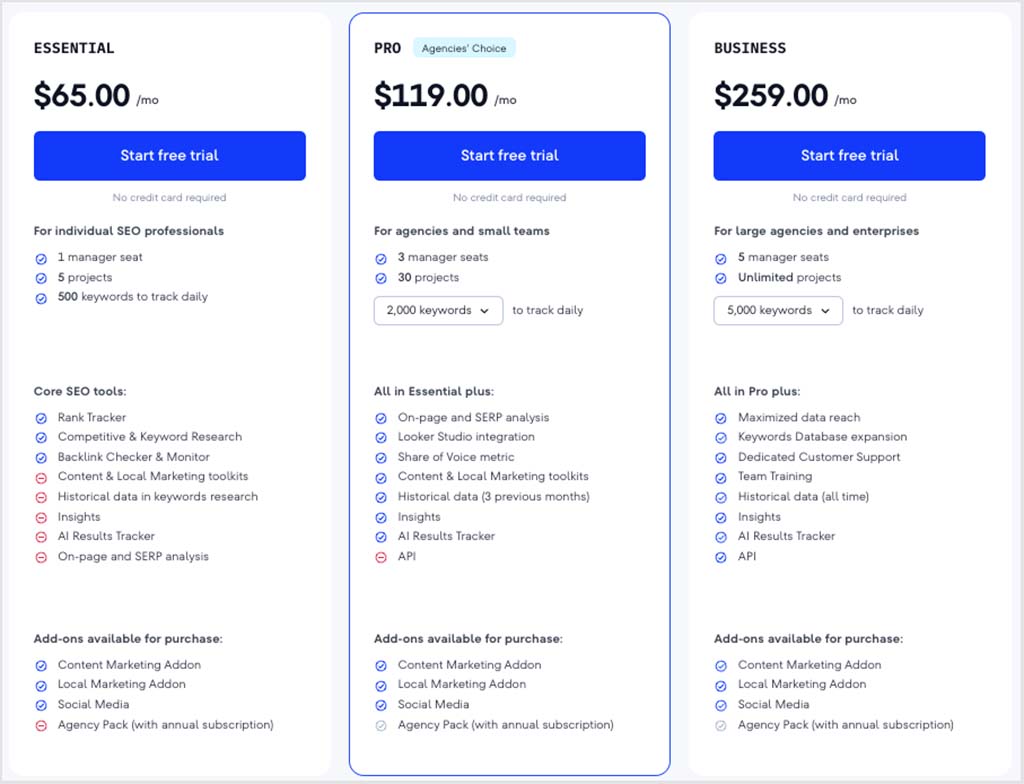
SE Ranking also offers more flexibility in terms of user access. Its higher-tier plans come with multiple user accounts by default (3-5 depending on plan), and if you need to add more seats, it’s a flat $20 per user — regardless of your plan.
With Ahrefs, the cost of extra users ranges from $40 to $80 per seat, generating additional costs that can quickly mount up. So, for teams that need to collaborate regularly across projects, SE Ranking’s approach is simpler and far more cost-effective.
Keyword tracking is another area where SE Ranking compares favorably against Ahrefs. The platform lets you choose how often rankings are updated — daily, every three days, or weekly.
Significantly, daily rank tracking in Ahrefs is only available if you pay a $200/month add-on — per project. That’s a hefty premium for a feature that SE Ranking includes as standard.
Additionally, SE Ranking lets you track more keywords at a lower price point. On its $119 pro plan, for example, you can track 2,000 of them for just $119 per month. Doing this with Ahrefs costs twice the price — you’ll need to be on its $249/mo plan to track the same number. And, as you go up both plans’ pricing ladders, you’ll find that Ahrefs remains the much cheaper option.
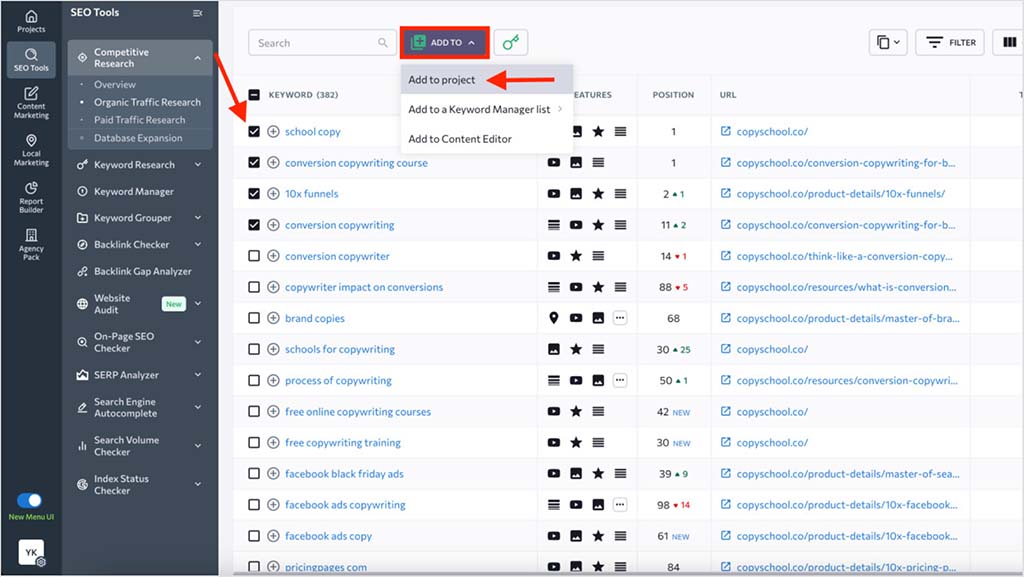
SE Ranking also includes several features that make it especially appealing to agencies. You can generate white-label reports featuring your own branding; automate their delivery; and control what clients or team members can see on them via user-level access permissions. SE Ranking even gives you a built-in lead generation widget — a useful bonus for agencies looking to convert website visitors into prospects. And again, the cost of unlocking these sort of features is roughly half what you’d pay with Ahrefs.
While SE Ranking’s keyword and backlink databases — around 5.9 billion keywords and 2.9 trillion backlinks — are smaller than Ahrefs’, I’ve found its data to be more than sufficient in practical use. It’s regularly updated, clearly structured and easy to interpret.
Thanks to its clean interface, lower barrier to entry, and flexible pricing, SE Ranking stands out as one of the best Ahrefs alternatives available — particularly for agencies, freelancers and small teams looking for flexibility and scale without the high price tag.
Key SE Ranking resources
Semrush
Semrush is one of the most feature-rich SEO platforms on the market — and while its pricing is broadly in line with Ahrefs’, it provides more functionality than its rival in quite a few areas, particularly where content marketing, technical SEO, and PPC data are concerned.
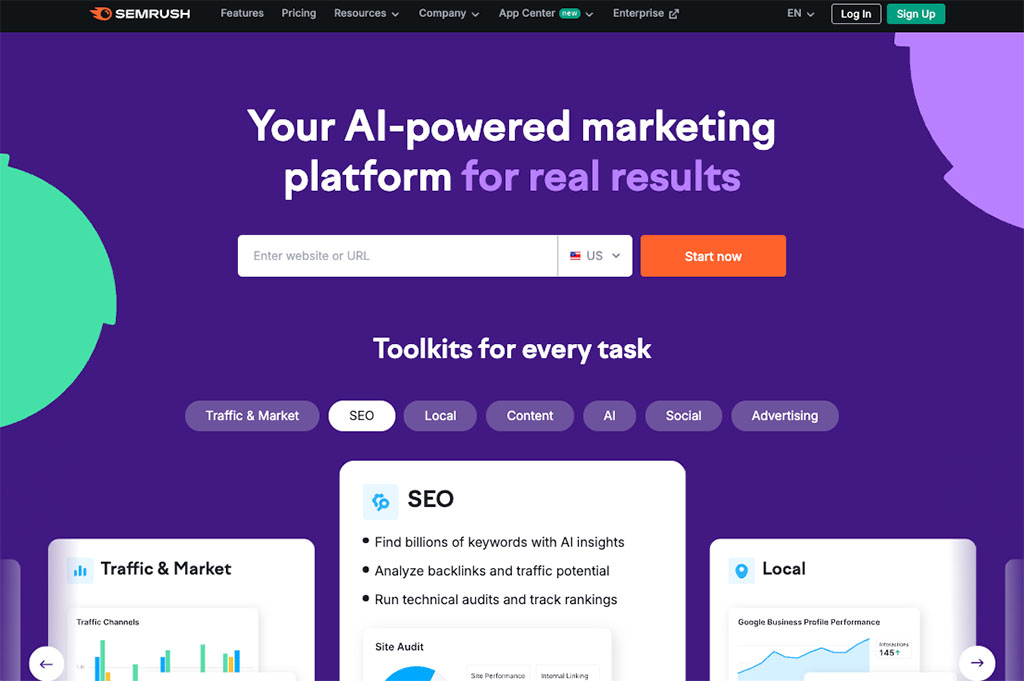
Its keyword research tools are especially strong. While Semrush’s keyword database is slightly smaller than Ahrefs’ — containing around 26.7 billion keywords compared to Ahrefs’ 28.7 billion — it arguably provides its keyword research data in a more usable way.
This is thanks to its provision of a personalized keyword difficulty score, which rather than giving you a generic estimate of how hard it will be to rank for a keyword, factors in data from your website to provide a more realistic appraisal of whether or not your domain should target a particular phrase. It does this by factoring in your site’s topical authority, backlink strength, and how well your existing content performs.
This personalized data is something Ahrefs doesn’t currently offer — which is a shame because in my experience, it really helps you avoid chasing the wrong keywords.
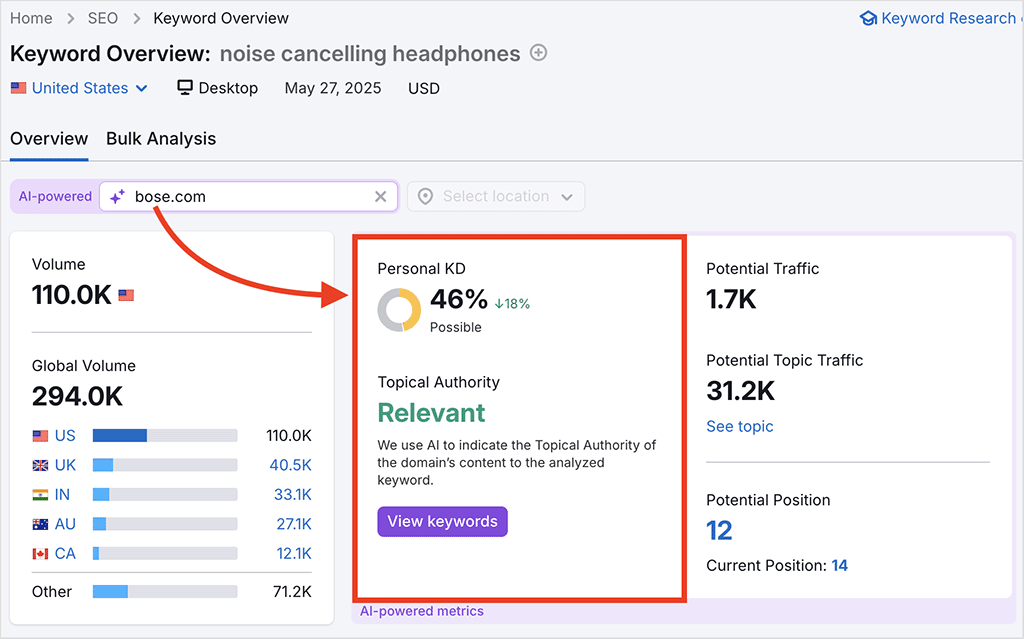
Semrush also gives you better access to historical keyword and competitor data. While Ahrefs caps the amount of this you can access at five years, Semrush lets you go back in time all the way to 2012. This depth can be useful when you’re trying to identify long-term trends, uncover seasonal patterns, or assess how a topic or competitor’s visibility has evolved over time.
Rank tracking is another area where Semrush wins on usability and value. Daily rank tracking is included on all plans — and unlike Ahrefs, doesn’t require you to fork out for costly add-ons to switch this feature on.
(As I discussed in the previous section on SE Ranking, Ahrefs only offers daily rank tracking updates if you pay for an expensive $200 per project per month add-on.)
Semrush also beats Ahrefs when it comes to backlink database size. At 43 trillion links, it contains eight trillion more than the Ahrefs database. This increased access to data will, on paper at least, give you more ways to spot backlink opportunities or benchmark your site’s backlink profile against those of competing domains.

Another thing that sets Semrush apart from Ahrefs is the inclusion of built-in link outreach tools. These let you identify link prospects, build outreach lists and — thanks to built-in a CRM-style tool — track campaign progress without involving any additional software. Significantly, Semrush surfaces contact details for link prospects wherever possible.
Ahrefs lets you spot backlink building opportunities easily enough, but these aren’t accompanied with any contact details. And unlike Semrush, it doesn’t give you any tools to help you manage the outreach process.
The key difference between Ahrefs and Semrush however is Semrush’s provision of a wider set of tools for digital marketing.
Semrush gives you really in-depth PPC campaign data; a content marketing toolkit; local SEO tools; and an integrated social media management suite. If you like, you can expand the platform’s functionality even further via an app center — this houses a growing collection of specialist marketing and SEO tools. Examples of the kind of add-ons available include competitor analysis tools; influencer identification apps; and link building managers.
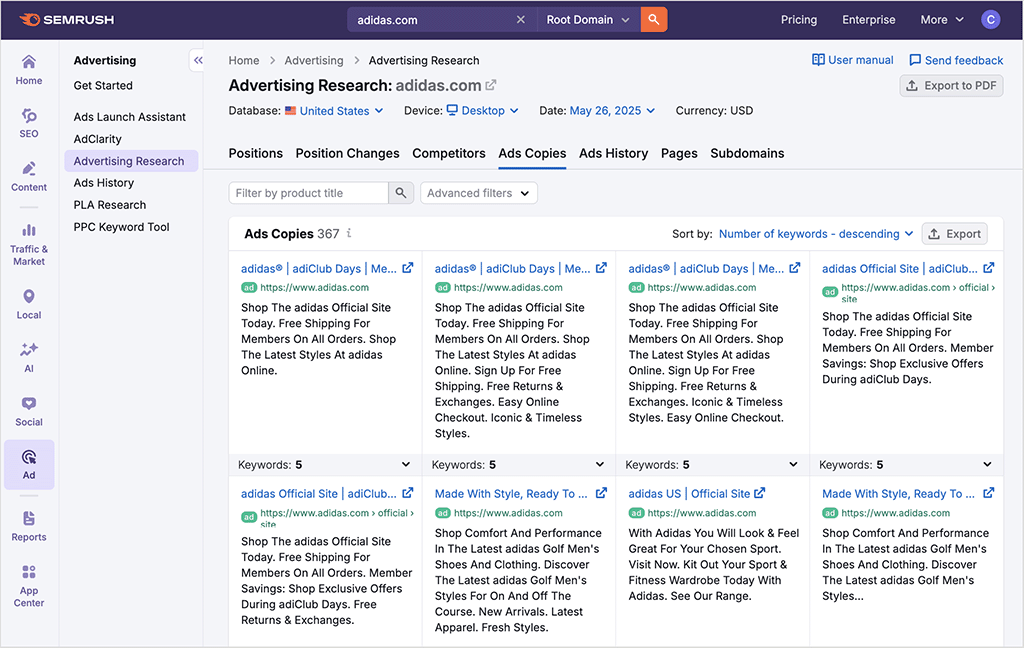
While its learning curve can be a little steep at first, Semrush provides plenty of in-platform guidance, along with tutorials, webinars and a large user community to help you get up to speed.
In most respects Semrush equals or betters Ahrefs — but it’s worth noting that Ahrefs is considerably more generous than Semrush when it comes to the number of websites you can track. So long as you can verify ownership of them, Ahrefs lets you work with an unlimited number of them, while Semrush caps the number of website projects you can work with according to plan. This makes Ahrefs a better choice for agencies.
And, if you’re using a higher-tier Ahrefs plan, no reporting limits are applied — but Semrush limits the number of daily reports you can access across all plans.
(That said, Semrush is a lot more generous than Ahrefs when it comes to reporting limits on its cheaper plans — for example, Ahrefs only lets you pull 500 reports per month on its $139/mo ‘Lite’ plan, while Semrush lets you pull 3,000 per day on its $129/mo ‘Pro’ plan.)
Ultimately, if you’re looking for a platform that goes beyond pure SEO — one that also supports content creation, paid search, and broader competitor intelligence — Semrush is one of the most capable options available. It’s not the cheapest tool, but for teams running integrated marketing campaigns and looking to manage everything in one place, it’s an extremely capable alternative to Ahrefs.
Key Semrush resources
Ubersuggest
Ubersuggest is an outlier on this list — not because it tries to compete head-to-head with Ahrefs on database size or depth of features, but because it offers a much simpler and cheaper way to access core SEO tools.
Starting at just $29 per month — and often available for as little as $10 with discounts — Ubersuggest gives you one of the most affordable entry points into SEO software. That low price doesn’t get you advanced agency-level features, but it does unlock keyword suggestions, backlink data, rank tracking, site audits and domain-level reports. For smaller sites or personal projects, that can be more than enough.
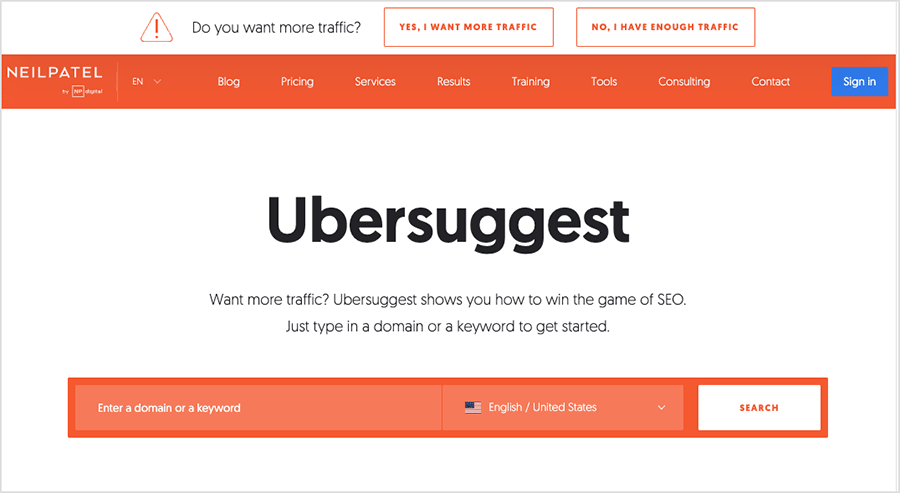
Unlike Ahrefs, which can feel intimidating to new users, Ubersuggest is designed with beginners in mind. Its interface is clean, its workflows are straightforward, and its reports are easy to make sense of — even if you’ve never used an SEO tool before. It’s a particularly good fit for solopreneurs, bloggers, and small business owners who want to dive into SEO without a steep learning curve.
Ubersuggest is also particularly strong when it comes to mobile usability. Its interface is fully responsive — meaning it automatically adapts to smaller screens — making it one of the few SEO tools that I’ve tested that’s practical to use on a phone or tablet. This means you can use Ubersuggest easily to carry out tasks like keyword research, site audits, or rank tracking while on the move.
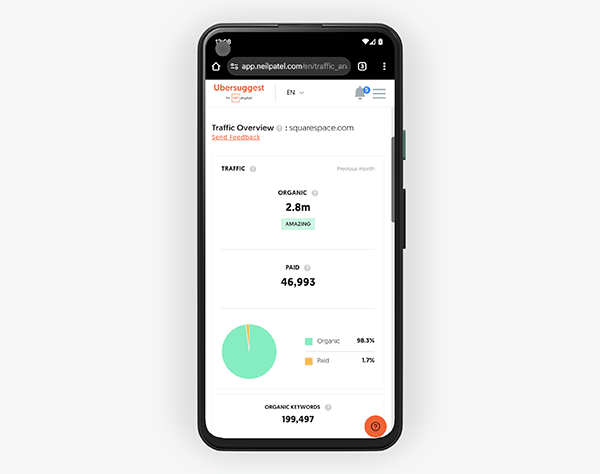
That said, Ubersuggest does come with some key limitations that are not present in Ahrefs.
First and foremost, its keyword data is powered by Moz — and this tool has a relatively small keyword database: 1.5bn keywords (for context, the Ahrefs keyword database contains 28.7bn). This means you’ll often see fewer suggestions than you would with tools like Ahrefs or Semrush that use much larger, proprietary databases.
(I found this lack of keyword data particularly noticeable when using Ubersuggest to research long-tail keywords or phrases to target in non-US markets.)
Second, while Ubersuggest does include key backlink research features — like referring domain reports and a backlink gap tool — the link analysis features are in general fairly lightweight. For example, it doesn’t give you features like disavow file exports, link velocity tracking or detailed anchor text breakdowns — all of which are available in more advanced platforms.
Additionally, Ubersuggest’s historical data is fairly limited. You can typically look back around two years, which may be sufficient for basic projects — but not for analyzing long-term trends, assessing the performance of legacy content, or researching a competitor’s historical visibility. Ahrefs, by contrast, offers access to keyword and backlink data going back to 2015, making it far more useful for deeper historical analysis.
But features aside, Ubersuggest includes some thoughtful extras that add real value. All its plans come with bi-weekly coaching calls and live Q&A sessions with Neil Patel’s team, which can be especially helpful if you’re new to SEO or need occasional guidance. Ubersuggest also gives you multi-user access on two out of its three plans, and the flexibility to add extra tracked keywords or projects at a very low cost.
Ultimately, if you’re running a large-scale SEO operation or need to perform in-depth competitive research, I wouldn’t recommend that you replace Ahrefs with Ubersuggest. But if you’re looking for a budget-friendly SEO toolkit that’s easy and pleasant to use, you’ll find it to be a good — and surprisingly capable — alternative.
Key Ubersuggest resources
Moz
Moz Pro has long been a respected name in the SEO world, and while it may not match Ahrefs in every department, it remains a strong and accessible option.
Starting at just $49 per month, it provides users with a solid set of SEO tools — keyword tracking, backlink analysis, site audits and domain-level reports. Its interface is clean and easy to navigate, making it well suited to beginners, small business owners and content-focused teams who want to focus fairly exclusively on SEO, and don’t need a full digital marketing suite.
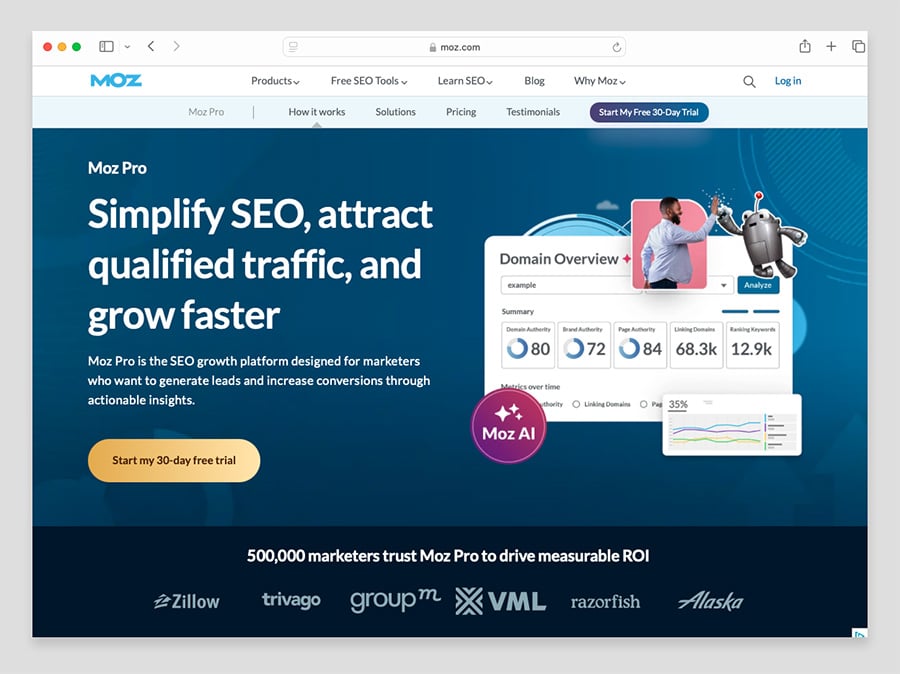
Two of Moz’s more distinctive features are its ‘Brand Authority’ score and ‘Domain Search Theme’ summary.
The first gives you a 1-100 rating for brand strength — a useful way to benchmark your reputation online, particularly given Google’s increasing focus on brand and trust signals.
The second identifies a site’s core topical focus based on search behavior, making it easier to check whether your content strategy is aligned with what your audience is actually interested in (or to assess the suitability of a potential outreach partner for link building or content collaboration purposes).
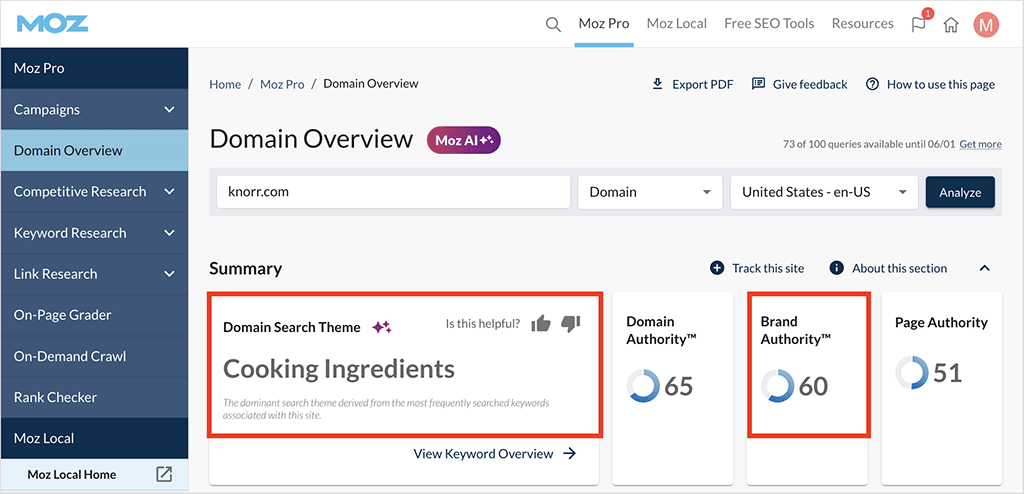
Moz’s backlink database is one of the largest available — currently containing 44.8 trillion links, making it larger than all the other platforms on this list. This means that you can expect solid data from Moz on referring domains, anchor text and link freshness (in our tests, we’ve consistently found that Moz surfaces more referring domain data than its rivals).
Technical site audits are another area where Moz scores highly, giving you generous auditing features at a very competitive price. On its $99 per month ‘Standard’ plan, Moz lets you crawl 400,000 pages per month — four times more than Ahrefs’ $129 ‘Lite’ plan does.
Even Moz’s $179 ‘Medium’ plan supports the crawling of 2 million pages — 500,000 more than facilitated by Ahrefs’ considerably more expensive Advanced plan (which costs $449/mo).
And if that’s not enough, you can crawl more pages without upgrading your Moz plan: extra crawl credits cost just $15 per 50,000 pages. If you’re managing large sites or auditing frequently, this flexibility is a major advantage.
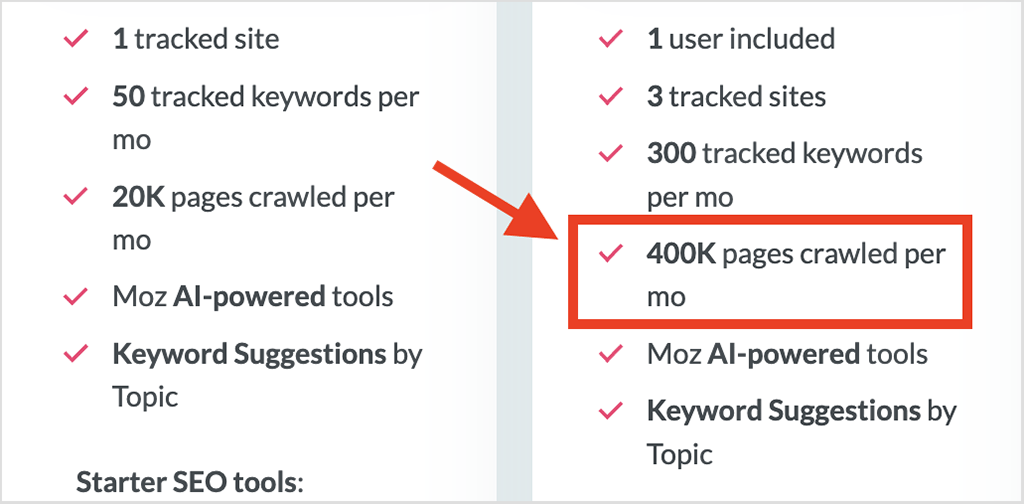
Another standout feature is Moz’s affordable API access. While Ahrefs only offers API access on its $1,499 Enterprise plan (and on top of that requires you to pay a $500 API usage fee), Moz lets you connect its data to your own apps from just $5/month — a rare and welcome level of accessibility.
There are trade-offs, of course. Moz’s keyword database is relatively small at 1.25 billion terms, meaning you’ll often get fewer keyword suggestions — particularly for long-tail keywords or outside the US.
(In fact, Moz caps the number of keyword suggestions you can access at just 1,000 — far, far fewer than Ahrefs and many other competing platforms.)
Furthermore, Moz doesn’t provide traffic estimates for competitor domains, which limits its usefulness for market and competitor analysis.
Still, for users focused on brand development, backlink building and site auditing, Moz is a fairly feature-rich and affordable choice.
Key Moz resources
Similarweb
Similarweb and Ahrefs both provide SEO insights — but they’re built for very different kinds of users. While Ahrefs focuses squarely on traditional SEO workflows like backlink analysis, keyword tracking and site audits, Similarweb is a digital intelligence platform first, and an SEO tool second.
Unlike Ahrefs — a tool that mainly focuses on traditional SEO tasks like domain analysis, link building and keyword research — Similarweb gives you a bigger picture. It can show you where a site’s visitors come from, how long they stay on that domain, and what other sites they visit.
In essence, a lot more competitor analysis and audience data is provided by Similarweb than competing tools.
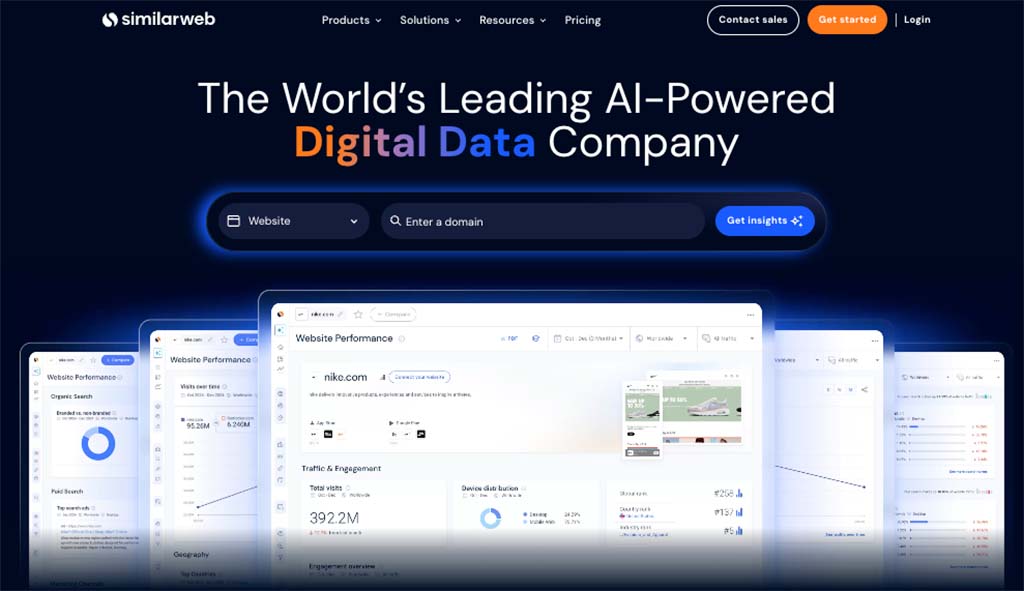
Similarweb maintains a large dataset covering 5+ billion keywords, 40,000+ apps, 200 million websites, and detailed product data on 235 million ecommerce SKUs. All this information becomes particularly useful when you’re doing competitive analysis — it can give you a great understanding of where your rivals get their traffic, how their audiences behave and what content formats are driving engagement.
But Similarweb can of course be used for SEO purposes, and not just for Google — it lets you perform keyword research for other search engines / platforms like YouTube, Amazon and Bing. You can filter keywords by geography, device type, and traffic source — and get unique insights on zero-click searches (where platforms return search results that are designed to keep people from visiting other websites).
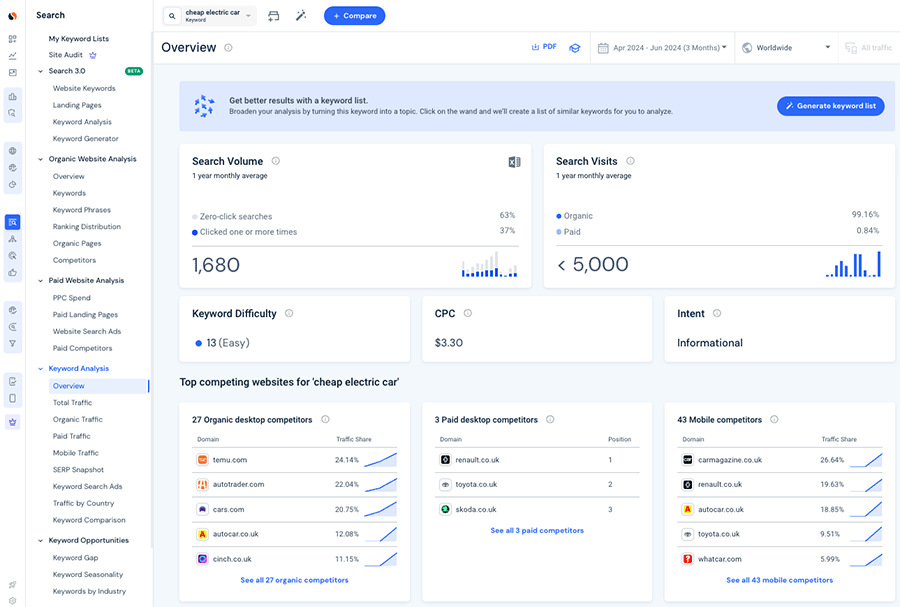
Similarweb also provides audience overlap reports that let you see which competitors share your traffic sources; these can help you uncover link-building or partnership opportunities. And while its technical site audit tool (covering 300+ SEO factors) is only available on enterprise plans, it’s one of the more comprehensive offerings on the market.
That said, for core SEO workflows, Similarweb’s pricing is a significant hurdle. It only offers a single plan with a monthly payment option — its $199 per month ‘Starter’ plan — and that excludes essentials like backlink data, rank tracking and site audits. To access these features, you’ll need to upgrade to a ‘Team’ plan or higher, with pricing starting at around $14,000 per year, billed annually.
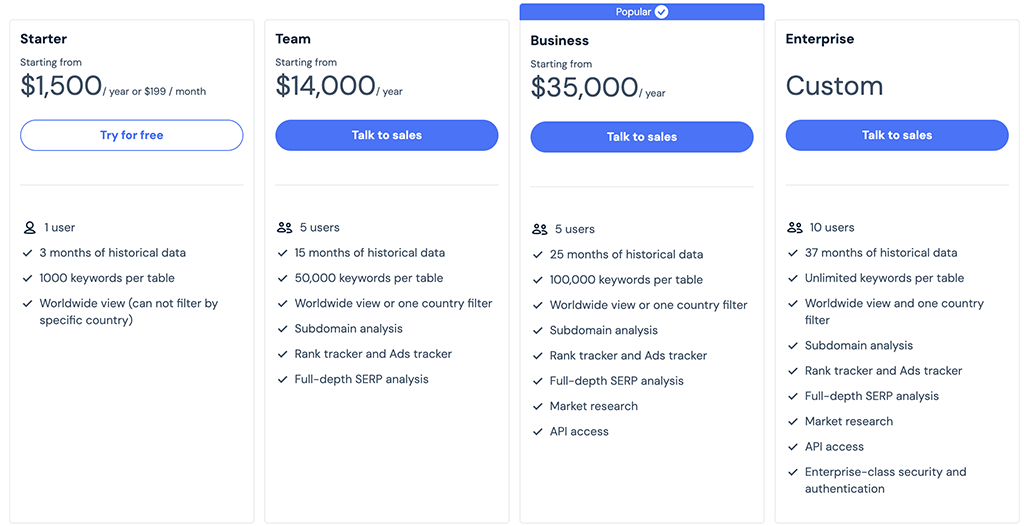
Still, for the right type of user, Similarweb can deliver valuable data insights. It’s not the best fit for those focused purely on search rankings or technical SEO, but it excels at providing high-quality data for teams working across SEO, digital strategy and market research.
If your goal is to benchmark performance, assess competitor growth and understand broader online behavior — all from a single interface — Similarweb is a serious contender. Just be prepared for enterprise-level pricing to match its enterprise-level scope.
Key Similarweb resources
Some other Ahrefs alternatives to consider
The tools above represent some of the most direct alternatives to Ahrefs. But the SEO landscape is full of other options, and here are a few more SEO platforms that might be worth considering:
- Majestic
- GrowthBar
- SEO PowerSuite
- Mangools
- Serpstat
- Screaming Frog
- seoClarity
- Raven Tools
We haven’t reviewed all of the tools listed above just yet — but we’re gradually working our way through them. Keep an eye on our SEO reviews and comparisons section for the latest updates as we continue testing and evaluating the top tools on the market.
And finally, please do leave a comment on this post if you have any queries about Ahrefs alternatives! We read them all and will do our best to help.
Don’t miss out on our free SEO toolkit
For a limited time only we’re offering our readers some excellent free SEO tools and resources. Sign up now to immediately receive:
- our downloadable cheatsheet containing the 20 key steps to ranking highly in search results
- extended free trials and discounts for leading SEO tools
- our downloadable cheatsheet on how to grow organic traffic to a blog
- 2 in-depth guides to SEO
- ongoing free tips and advice on SEO and growing your business
No comments